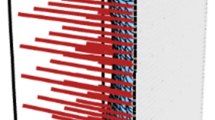Abstract
Some investigators have indicated that mathematical theories and computational models of bone adaptation may not converge and that the density solutions from such simulations are dependent on the initial density distribution In this study, two-dimensional finite element models were used to investigate the effect of initial density distribution on the final density distribution produced using a node-based bone remodeling simulation. The first model was a generic long bone, and the second was a proximal femur. For each model, we conducted time-dependent, node-based, linear rate-law bone remodeling simulations. Five initial density conditions were used with the generic long bone and three with the proximal femur. Remodeling simulations were performed, and the largest average nodal density differences at the end of the simulations were 0.000010 g/cm3 and 0.000006 g/cm3 for the generic long bone and proximal femur models, respectively. Results illustrate that, for a given set of loads and a given finite element model, the node-based bone adaptation algorithm can yield a unique density distribution. In conjunction with previous studies, this finding suggests that uniqueness of the density solution is dependent on both the mathematical theory and the computational implementation.
Similar content being viewed by others
References
Beaupré, G. S., T. E. Orr, and D. R. Carter. An approach for time-dependent bone modeling and remodeling—application: a preliminary remodeling simulation.J. Orthop. Res. 8:662–670, 1990.
Beaupré, G. S., T. E. Orr, and D. R. Carter. An approach for time-dependent bone modeling and remodeling—theoretical development.J. Orthop. Res. 8:651–661, 1990.
Carter, D. R.. Mechanical loading histories and cortical bone remodeling.Calcif. Tissue Int. 36:19–24, 1984.
Carter, D. R.. The relationship between, in vivo strains and cortical bone remodeling.CRC Crit. Rev. Biomed. Eng. 8:1–28, 1982.
Cowin, S. C.. Bone modeling of diaphyseal surfaces by torsional loads: theoretical predictions.J. Biomech. 20:1111–1120, 1987.
Frost, H. M.. Sekeletal structural adaptations to mechanical usage (SATMU). 2. Redefining Wolff's law: the remodeling problem.Anat. Rec. 226:414–422, 1990.
Huiskes, R., H. Weinans, H. J. Grootenboer, M. Dalstra, B. Fudala, and T. J. Slooff. Adaptive bone-remodeling theory applied to prosthetic-design analysis.J. Biomech. 20:1135–1150, 1987.
Jacobs, C. R. Numerical simulation of bone adaption to mechanical loading. Stanford, CA. Stanford University. Ph.D. Dissertation, 1994, pp. 1–127.
Jacobs, C. R., M. E. Levenston, G. S. Beaupré, and J. C. Simo. A new implementation of finite element-based bone remodeling. In: Recent advances in computer methods in biomechanics & biomedical engineering, edited by J. Middleton, G. N. Pande, and K. R. Williams. Swansea, UK: Books & Journals International Ltd., 1992, pp. 20–29.
Jacobs, C. R., M. E. Levenston, G. S. Beaupré, J. C. Simo, and D. R. Carter. Numerical instabilities in bone remodeling simulations: the advantages, of a node-based finite element approach.J. Biomech. 28:449–459, 1995.
Martin, R. B.. Porosity and specific surface of bone.CRC Crit. Rev. Biomed. Eng. 10:179–222, 1984.
Mullender, M. G., and R. Huiskes. Proposal for the regulatory mechanism of Wolff's Law.J. Orthop. Res. 13:503–512, 1995.
Mullender, M. G., R. Huiskes, and H. Weinans. A physiological approach to the simulation of bone remodeling as a self-organization control process.J. Biomech. 27:1389–1394, 1994.
Orr, T. E. The role of mechanical stresses in bone remodeling. Stanford, CA: Stanford University, 1990, pp. 1–151.
Turner, C. H., V. Anne, and R. M. Pidaparti. Convergene and Uniqueness of Bone Adaptation Models, vol. 18. Transactions of the 39th Annual Meeting of the Orthopaedic Research Society, San Francisco, CA, 1993, pp. 1–527.
Weinans, H., R. Huiskes, and H. J. Grootenboer. The behavior of adaptive bone-remodeling simulation models.J. Biomech. 25:1425–1441, 1992.
Weinans, H., R. Huiskes, and H. J. Grootenboer. Convergence and uniqueness of adaptive bone remodeling, vol. 14. Transactions of the 35th Annual Meeting of the Orthopaedic Research Society, Las Vegas, NV, 1989, pp. 1–310.
Author information
Authors and Affiliations
Rights and permissions
About this article
Cite this article
Fischer, K.J., Jacobs, C.R., Levenston, M.E. et al. Observations of convergence and uniqueness of node-based bone remodeling simulations. Ann Biomed Eng 25, 261–268 (1997). https://doi.org/10.1007/BF02648040
Received:
Revised:
Accepted:
Issue Date:
DOI: https://doi.org/10.1007/BF02648040




